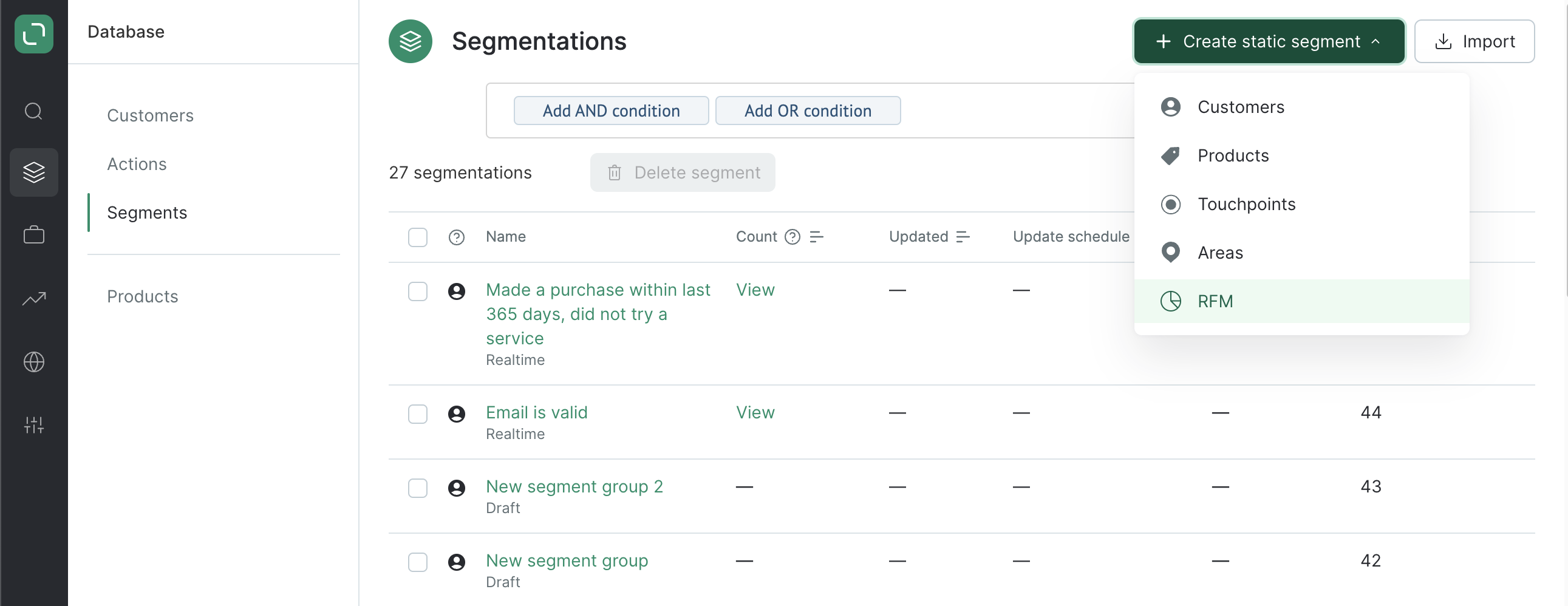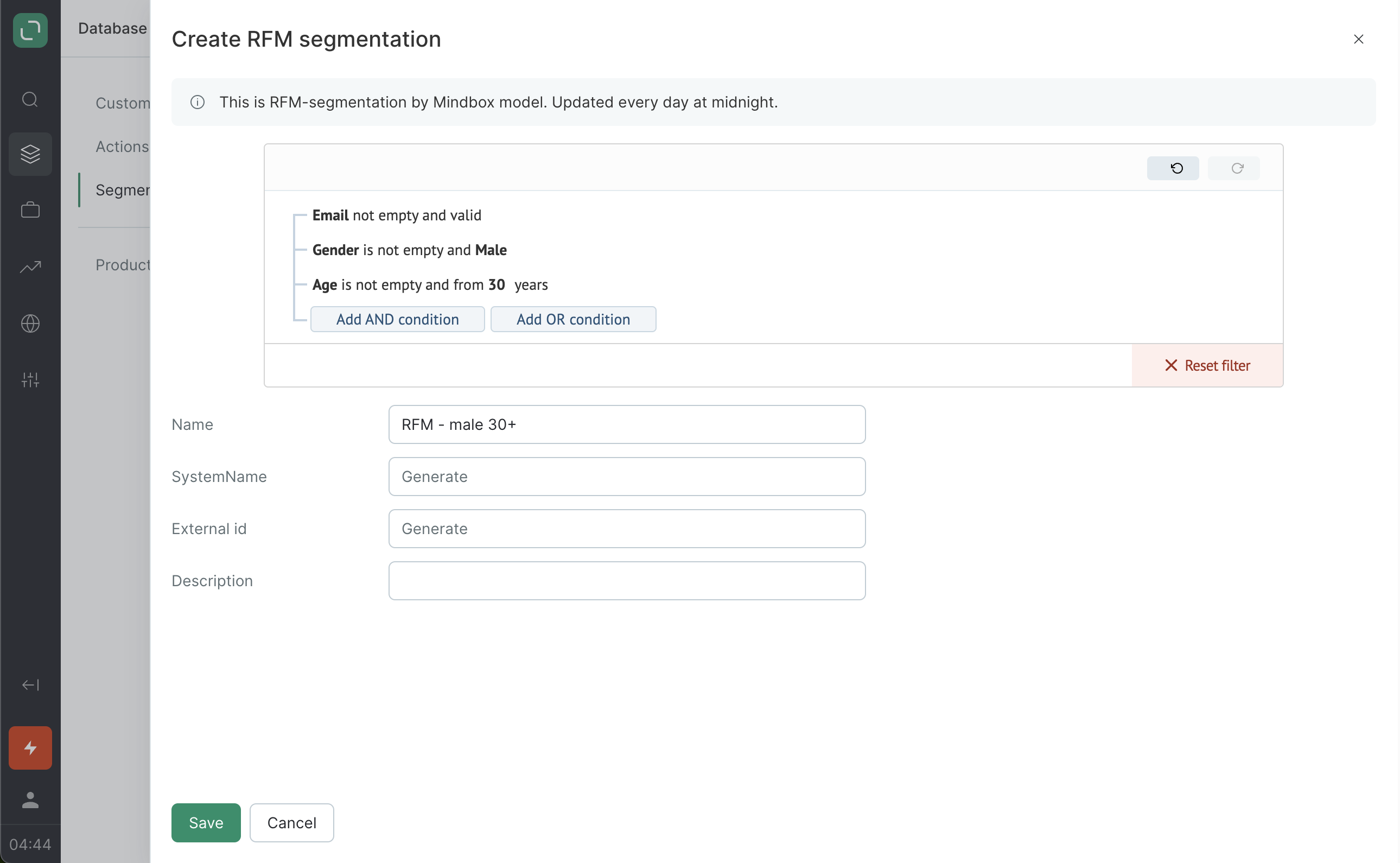RFM segmentation is an algorithm used to segment a database using RFM analysis. RFM analysis filters customers into segments according to their purchases using the following three factors:
- Recency (the time since a customer last made a purchase);
- Frequency (how often the customer made purchases);
- Monetary value (the total amount of money the customer has spent).
RFM analysis provides the basis for the future customer interaction: for example, a marketer can decide whether or not to offer an additional discount in a campaign depending on a customer’s segment. The model takes into consideration the data on the purchases made over the previous year.
RFM segmentation requires data on orders and personal actions over the period of at least one year.
How does RFM segmentation work?
RFM segmentation is completed automatically. Click "Create RFM" to launch the algorithm and segment the database. This will automatically divide it into 13 RFM segments. Your customers will automatically fall into the created segments.
The contents of the RFM segments are updated every day (at 12:00 a.m.). You can update these manually if necessary.
The algorithm scores customers on each of the factors and calculates the segments’ boundaries every day.
RFM algorithm assigns a score from 1 to 5 for all customers on each of the following factors:
- Recency (R—the time since a customer last made a purchase);
- Frequency (F—how often the customer made purchases);
- Monetary value (M—the total amount of money the customer spent).
The algorithm applies relative indicators, i.e. all the users who were active over the previous year (made purchases) are divided according to frequency of their purchases (how many orders each customer made over the previous year), the total monetary value of their transactions, and recency of the purchases.
After that, all the customers are divided into 5 equal groups, ranging from F=1, containing 20% of customers who made the least number of orders over the year (compared to other users) to F=5 with the 20% of customers who made the most orders over the year.
The results for Recency (when the last purchase took place) and Monetary value (how much money the customer spent over the year) are calculated the same way.
Finally, the algorithm assigns an index for each user. For example, 555 refers to a customer that belongs to the top 20% in Recency, Frequency, and Monetary value categories. 111 refers to the most inactive segment in each category and includes the customers who bought something once and never returned.
Each index (group) of customers refers to one of the 13 segments:
| Segment | Groups | Description |
|---|---|---|
| Champions | 555, 554, 544, 545, 454, 455, 445 | Customers who have made a purchase recently, order frequently, and spend the biggest amounts. When communicating with these customers, focus on highlighting exclusive and unique products, as well as new releases. There is no need to communicate often or incite them with discounts. Send messages inciting them to buy more often or more expensive products. |
| Loyal | 543, 444, 435, 355, 354, 345, 344, 335 | Customers who make purchases consistently; some of them may become champions. For this group: 1) Do not let the frequency of their purchases fall; use standard campaigns to maintain loyalty. 2) Grow new champions: Gradually increase the average order value with slightly more expensive items. 3) For the customers who respond well to the first two strategies: promote what is popular with the champions. |
| Potential loyal | 553, 551, 552, 541, 542, 533, 532, 531, 452, 451, 442, 441, 431, 453, 433, 432, 423, 353, 352, 351, 342, 341, 333, 323 | Customers who purchase a little less frequently or have spent a smaller total than required to be considered loyal customers. Promote the most popular products to these customers — your main objective is to increase their loyalty by offering special loyalty program terms, etc. |
| New customers | 512, 511, 422, 421 412, 411, 311 | Customers who have bought something for the first time or for the first time in a long while. In your messages, focus on your popular products to incite this category of customers to purchase again. |
| New customers (no orders) | Took their first action over the last 60 days, have bought nothing yet | Customers who have not yet made a purchase. Encourage them to buy something and focus on popular items when recommending products. |
| Promising | 525, 524, 523, 522, 521, 515, 514, 513, 425 424, 413 414 415, 315, 314, 313 | Offer membership in the loyalty program and personal recommendations. |
| Need attention | 535, 534, 443, 434, 343, 334, 325, 324 | Strategy: Provide time-bound offers and personal recommendations. |
| Almost dormant | 331, 321, 312, 221, 213, 231, 241, 251 | Customers in this segment have not made purchases for a relatively long time, but not so long that you would consider them a part of your customer churn. Try to work with their interests and incite them to make another purchase by offering discounts. |
| Too valuable to lose | 155, 154, 144, 214 215 115, 114, 113 | Customers who used to buy a lot and often, but have stopped doing so. Interest them with updates or new products; talk to them, if necessary. Spend time on personalizing your messages as much as possible. |
| Churn risk | 255, 254, 245, 244, 253, 252, 243, 242, 235, 234, 225, 224, 153, 152, 145, 143, 142, 135, 134, 133, 125, 124 | This group is very similar to High-value customers, but its members have recently made a purchase. This segment may be even a bit more valuable than High-value customers, as the members of this group are more likely to respond. Use the same approach when working with this group as with High-value customers. |
| Dormant | 332, 322, 233, 232, 223, 222, 132, 123, 122, 212, 211 | Include these customers in your standard email campaign, but check regularly to see if they mark your messages as spam. Do not interact with them through paid channels. |
| Churned | 111, 112, 121, 131 141 151 | Send thank-you emails with recommendations. |
| Churned (no recent orders) | Took their first action more than 60 days ago, have bought nothing over the reporting period | This segment has the lowest priority. Do not waste resources on this segment as these customers are unlikely to return or they will do it with a small purchase. |
How to create RFM segmentation
Go to Database → Segments → Create static segment → RFM:

- Set up a filter or leave it empty (this way the segmentation will cover the entire database), specify a name. If you have a multi-brand project, select a brand:

When you select a brand, the segmentation will include only the customers who have taken actions with the brand specified.
- Click Save.
How to view RFM segmentations
Go to Database → Segmentations. The RFM segmentations stand out from other segmentations since you can view them as dropdown lists.
How to delete an RFM segmentation
Delete an RFM segment the way you would delete a segment using filter conditions.
How to edit an RFM segmentation
- Go to Database → Segments → click the name of the segmentation.
- You can change the filter, name, or brand in the window.
- Click Save.